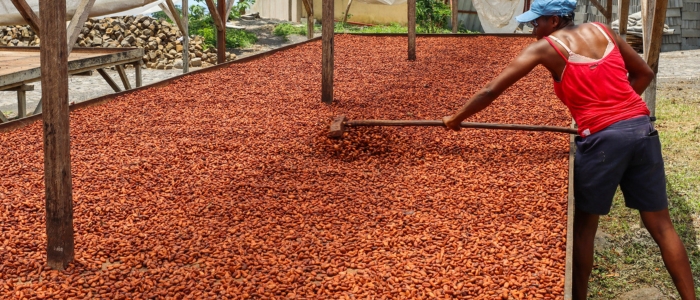Cocoa Agroforestry System in Sao Tome and Principe
GIAHS since 2024

Detailed Information | Partners | Annexes |
|---|
Global Importance
The Cocoa Agroforestry System of Sao Tome and Principe is of global significance due to its production of the unique Amelonado Seleção de São Tomé (SST) cocoa, the only amelonado variety recognized by the International Cocoa Organization as fine cocoa. This system not only contributes to the global chocolate industry with its high-quality cocoa but also exemplifies sustainable agricultural practices. By maintaining genetic diversity and employing sustainable practices such as shade-grown and organic farming, the system offers a valuable model for balancing agricultural productivity with environmental conservation.
Food and Livelihood Security
The agroforestry system in Sao Tome and Principe is vital for ensuring food security and sustainable livelihoods for local communities. Cocoa is a major source of income through exports, but the system's integration of diverse crops like bananas, breadfruit, and taro (locally known as matabala) provides additional food sources and income streams. This diversification reduces reliance on a single crop, enhancing resilience against market fluctuations and environmental stresses. As a result, the system supports both the economic stability of farming families and the nutritional needs of the local population. The unspoilt and wild nature attracts different types of tourists, including scientific tourism.
Agrobiodiversity
Agrobiodiversity is a fundamental aspect of the Cocoa Agroforestry System in Sao Tome and Principe. The system includes a variety of crops, such as cocoa, bananas, breadfruit, and medicinal plants, which are cultivated in a multi-layered arrangement that mimics natural ecosystems. This diversity enhances ecological functions like nutrient cycling, pest control, and soil fertility, reducing the need for chemical inputs and increasing resilience to environmental changes. Additionally, the system preserves unique genetic resources, such as the Amelonado SST cocoa variety, which are crucial for maintaining global biodiversity and adapting to future challenges.
Local and Traditional Knowledge Systems
The Cocoa Agroforestry System of Sao Tome and Principe, developed during Portuguese colonization, has been shaped by the traditional knowledge of local communities over generations. Originally focused on cocoa monoculture, the system evolved to incorporate multiple layers of crops, including bananas, jackfruit, breadfruit, and nitrogen-fixing trees like Erythrina, which improve soil fertility. This multi-layered approach not only supports cocoa production but also enhances local food security and biodiversity. By combining traditional practices with sustainable land use, this agroforestry system preserves cultural heritage and demonstrates the resilience of the Santomean people.
The system is structured in four distinct layers, each contributing to its overall sustainability. The upper canopy consists of tall trees that provide shade and protect cocoa plants from direct sunlight. Below this layer, medium-height trees like fruit trees offer additional shade and diversify the produce. The third layer includes cocoa trees themselves, while the fourth layer consists of smaller shrubs and nitrogen-fixing plants that enrich the soil. Finally, the ground layer is made up of low-growing crops and cover plants that prevent soil erosion. This stratified design maximizes land use, supports diverse ecosystems, and enhances resilience against environmental changes.
Cultures, Value Systems, and Social Organizations
The agroforestry system is deeply intertwined with the cultural identity and social fabric of Sao Tome and Principe. Initially developed during a period of colonial rule, when African people were enslaved to work on cocoa plantations, the system has historically contributed to social inequalities. Over time, however, there has been a transformation towards cooperativism and fair trade, empowering local farmers, promoting social equity, and supporting sustainable development. These cooperatives preserve traditional agricultural practices and cultural values associated with cocoa farming, fostering a sense of community and continuity that strengthens social cohesion and supports a sustainable, equitable agricultural model.
Landscapes and Waterscapes Features
The landscapes and waterscapes of the Cocoa Agroforestry System in Sao Tome and Principe are characterized by a unique blend of cultivated and natural elements. The multi-strata design, which incorporates various crops at different levels, resembles natural forest structures, contributing to soil conservation, water management, and biodiversity. This arrangement supports ecological balance by providing habitats for numerous species and maintaining the integrity of watersheds, which are essential for water quality and availability. Additionally, the system’s sustainable land use practices, such as erosion control and water retention, are well-suited to the region’s steep slopes, enhancing both agricultural productivity and environmental conservation.

